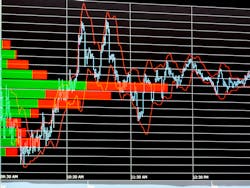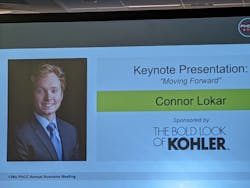Moving Forward: What to Expect in 2022
KANSAS CITY, MO — Following the annual PHCC business meeting, voting and elections, the Kansas City Convention Center hall welcomed PHCC CONNECT 2021 attendees to hear the Friday Keynote speech, an economic forecast delivered by Connor Lokar, Senior Forecaster for ITR Economics, a firm that offers economic insight and consulting to a wide range of industries including manufacturing, real estate, technology and construction.
Lokar was introduced by Elisabeth Sutton, Director of Marketing for Kohler Co. Sutton reflected on the previous 19 months, and, while acknowledging the success of many contractors, highlighted the nagging difficulties that still plague the industry: supply chain problems, labor shortages, uncertainty surrounding regulation, and ongoing difficulties related to the pandemic.
Sutton closed saying Kohler Co. was committed to supporting the industry, and the success of individual contractors. "I wish you the very best, and a strong finish to the year."
Lokar then took the stage. He started on a personal note, telling the audience he had proposed to his now-wife in 2019, only to have to re-think all their marriage plans. He had married in May of 2021, but the ceremony was, necessarily, on a much smaller scale.
But these kind of disruptions, Lokar said, are the sort of thing we have become accustomed to in both our personal, and our professional lives. He then launched into the substance of his talk, which was intended to deliver actionable economic intelligence, or, as his firm likes to phrase it, "What's happening now, what's happening next, and what can we do about it?"
What's Happening Now
The US GDP saw a dip in Q4 of 2019 due to COVID, then things fell off a cliff in 2020—but we managed to rebound, and contracting helped to lead that rebound. A lot of people staying at home during the pandemic meant a lot of people chose to improve their homes. The new "work from home" directives meant a lot of workers were suddenly free to work from anywhere, and many chose to change homes. A lot of people left urban areas because the things that attracted them to cities—public events, restaurants, office buildings—were no longer part of the equation.
Now, the economy is decelerating, and this can be seen in a lot of leading indicators (such as housing permits issued). GDP is going to decline, and there will certainly be some "doom and gloom" in the business media as they report on the decline. But keep in mind, we will still see top-line growth, just at a much slower pace than we experienced last year. Lokar predicted that by 2023/2024 the US economy will be ready for a new cycle of expansion and growth.
What Happens Next
A lot of businesses in all facets of the construction industry have seen significant backlog over the past year—more work booked than they could get to. Lokar cautioned his audience to be wary of the coming year, and not to simply straight-line their 2022 forecast. Volume of work out there will simply not be the same. "Let's not get too far out over our skis," he said.
Why? Consumers are coming back down to earth. In 2020 it looked like the sky was falling and a lot of businesses—entire industry segments—shut down overnight. But it quickly came roaring back. We witnessed 2X, 3X even 4X the normal growth rate of consumer spending (some of this was due to government stimulus). There was something in the region of $15.6 trillion in consumer spending this past year. But it does not look like consumers will continue to spend the way they have.
Inflation is one reason. 2% is a rate of inflation most people are comfortable with—it practically seems priced into the economy. But, if wages are only increasing 1%, that becomes a losing equation. Likewise, 5%-6% inflation is not good, but if earnings are keeping pace it doesn't need to be a disaster. And just now, inflation is starting to bite the consumer; dollars are starting to lose their punching power.
Another concern is the tight and tightening labor market. It's almost impossible to hire people, Lokar said, at almost any position (and almost everyone in the audience nodded in agreement). For every job on offer, there is something less than one person (0.8%) chasing that job. But, he added, that tight labor market will actually act as a cushion for the slowing economy next year.
Significantly for the skilled trades, the largest draw-down in labor force participation in the last two years has been people over 60, older people who chose either to retire or take early retirement.
In a nutshell, if you are en employer, the labor market will remain a thorn in your side in the coming year. Finding new people will remain difficult, although turnover may decrease.
Supply Chain Issues
Keep in mind, Lokar said, these economic problems are not just North American problems, they are global problems. The whole world will be feeling the coming slow-down.
Suppliers will start to see some of the pressures come off as the economy re-balances. We are pretty much at the top of the cycle right now; once we get past the peak we will see some relief on pricing pressures.
The difficulties you are experiencing, Lokar insisted, are not because your channel partners have not been moving forward, it's because demand has been moving backward. Container through-put is at the highest level it has ever been. Almost every US port is at record or near-record levels for delivery.
The sky was falling and everyone went into a pull-back, including suppliers. Consumers could just flip a switch and get back to buying—but suppliers don't move that fast. Next year will see better lead times. Things may get worse before they get better, but they will get better.
Markets
Housing is at the bleeding edge of the business cycle. It is a very consumer-driven market, and a leading indicator, so many contractors are working at the edge of the current crisis.
For the commercial side of the industry, they have probably already seen the worst and worked through it. The commercial market actually looks much better for 2022/2023. In the same way, things are starting to get tough for the residential side of the market. A lot of consumers have already bought, and it is starting to get difficult to get land for residential development. Again, there will continue to be growth, just not anywhere near the 2020/2021 level. State single family permits are down, quarter-over-quarter, in most states (-14.2% decrease in the Northeast region).
What Can We Do About It?
"Good data is how you get out of a reactive mind-set," Lokar said, "and base your decisions on what will happen as opposed to what's going on now."
According to the National Association of Home Builders, home builder sentiment is eroding. As home sales decelerate, the remodeling market will in turn decline (people tend to remodel right after they buy, or right before they sell, a home).
It is a different year coming, but it does not look like the Great Recession of 2007-2008—we are not in a bubble. While some aspects of the current market do look unhealthy (buyers waiving inspections and so forth), inventories still look healthy. Low mortgage rates should keep a reasonable floor on the cycle. If the bond market starts to go crazy, that might be a warning sign, but right now things look fairly stable.
Population growth is a driver of economic growth. Looking at the various states, Texas (for example) has seen its population grow by +5.2%. Illinois, on the other hand, has seen its population decline by -1.8%. Population means more workers, more taxpayers and more consumers.
Over the next decade we will see more state-level tribalism, Lokar said. That, combined with the aging Baby-boomers (and how we care for them as they enter old age) will be a difficult challenge.
The thing to do, Lokar said, is to take a good hard look at your markets and decide if they are heading for a soft landing or a hard landing. Stay on top of aging receivables. Revisit capital expenditure plans.
There is a lot of uncertainty in Washington right now, a lot of things to make for an interesting Fall, but with the right mindset, and the right information, there is no reason why your business can't take advantage of the market conditions—whatever those conditions might be—to find your own pathway to prosperity and success.

